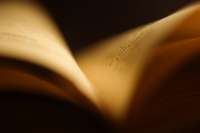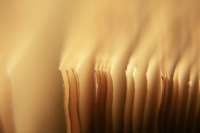The library is a project about books and readers. It consist of two parts, one is the photographic register of books rescued from the street, the beach, or even from the garbage, over my years of immigrant in Israel.
los libros de la biblioteca no tienen letras cuando los abro surgen
library books have no words when I open them they come up Jorge Luis Borges
Introduction
As an Argentinean immigrant in Israel I had to struggle with life in a place where an unknown language is spoken.
I started taking pictures of every page of my Spanish-Hebrew dictionary, as if their pages were a world through which
I could travel, or a beautiful body to discover, and whose meanings would be revealed to me through the light.
In the midst of this exploration a very strange thing happened: one day I found about twenty abandoned books in the street. They seemed to be part of the same library because they were printed in German and most of them were valuable 19th century editions.
I included these books in the process, while I continued rescuing more books from the street, the beach, or even from the garbage. I photograph them, looking for the emotional and sensory experience in the simple act of opening a book, knowing that there will be a meeting, a memory, a journey or a mirror, even in a language I can't understand. Most of the books I have gathered were published in the first half of the 20th century, with some from the late 1800's. They have come from all parts of the world, and they are printed in English, French, Spanish, German, Russian, Polish, Romanian, Hebrew and Arabic.
Over the past four years, a strange and special library has taken shape, where classic and unknown authors coexist, and which includes theatre, novels, essays and dictionaries; philosophy, phonetics, poetry and music. I focus on their spatial and visual coordinates: their open pages, covers, shapes and textures, type of paper, the typography or their printed language with the aim to reveal through my images some fragment of the book's own story and its quality as a conjunction of matter and spirit.
Even if the books will not be read, as a photographer, I prepare myself for the act of reading, in a kind of open dialogue of discovery and revelation. While more books have become virtual, and many prophesize their disappearance as we know them today, it would seem that I am following an inverse route. Nevertheless, I believe that "the book will endure with the same shape it assumed more than five hundred and fifty years ago, because someone will always prefer or rather will choose to establish an intimate relationship with an author in this manner, through pages gaining life while they are being opened “1
The project Although some of the images were exhibited in other group exhibitions, I consider the project as a unity that should show its images together. On further reflection, I thought I also needed to find a destination for the books themselves, since every text calls to a reader to find his own essence in this encounter. Therefore, the project would consist of two parts, one related to the books and the other related to the images produced through them.
The Library includes at this stage about 50 books, which have come to me by chance, thus I have considered assigning an addressee to each of them, choosing by chance a reader whose language is that of the book, for the books to be read once again.
The attached map shows the fourteen cities of origin of the books, and where the books would return as they are sent to new readers. The shipping would be done in a specially designed package, with an accompanying text written by a writer or poet about the book and the project.
Regarding the books’ images, I would continue the photographic process to edit up to 25 or 30 representative images, both for exhibition and for a limited edition of a new book, where every page will belong to a different book. Copies would be sent to different libraries in different parts of the world.
In this manner the rescued books will become part of a network that will assemble different times, authors, languages, countries and readers, binding them together in a new book that will contain and multiply them, while tracing a new route in their return journey, where they will again meet and be cherished by a new reader.
Liliana Gelman
Haifa, spring 2007
The library is a project about books and readers. It consist of two parts, one is the photographic register of books rescued from the street, the beach, or even from the garbage, over my years of immigrant in Israel.
los libros de la biblioteca no tienen letras cuando los abro surgen
library books have no words when I open them they come up Jorge Luis Borges
Introduction
As an Argentinean immigrant in Israel I had to struggle with life in a place where an unknown language is spoken.
I started taking pictures of every page of my Spanish-Hebrew dictionary, as if their pages were a world through which
I could travel, or a beautiful body to discover, and whose meanings would be revealed to me through the light.
In the midst of this exploration a very strange thing happened: one day I found about twenty abandoned books in the street. They seemed to be part of the same library because they were printed in German and most of them were valuable 19th century editions.
I included these books in the process, while I continued rescuing more books from the street, the beach, or even from the garbage. I photograph them, looking for the emotional and sensory experience in the simple act of opening a book, knowing that there will be a meeting, a memory, a journey or a mirror, even in a language I can't understand. Most of the books I have gathered were published in the first half of the 20th century, with some from the late 1800's. They have come from all parts of the world, and they are printed in English, French, Spanish, German, Russian, Polish, Romanian, Hebrew and Arabic.
Over the past four years, a strange and special library has taken shape, where classic and unknown authors coexist, and which includes theatre, novels, essays and dictionaries; philosophy, phonetics, poetry and music. I focus on their spatial and visual coordinates: their open pages, covers, shapes and textures, type of paper, the typography or their printed language with the aim to reveal through my images some fragment of the book's own story and its quality as a conjunction of matter and spirit.
Even if the books will not be read, as a photographer, I prepare myself for the act of reading, in a kind of open dialogue of discovery and revelation. While more books have become virtual, and many prophesize their disappearance as we know them today, it would seem that I am following an inverse route. Nevertheless, I believe that "the book will endure with the same shape it assumed more than five hundred and fifty years ago, because someone will always prefer or rather will choose to establish an intimate relationship with an author in this manner, through pages gaining life while they are being opened “1
The project Although some of the images were exhibited in other group exhibitions, I consider the project as a unity that should show its images together. On further reflection, I thought I also needed to find a destination for the books themselves, since every text calls to a reader to find his own essence in this encounter. Therefore, the project would consist of two parts, one related to the books and the other related to the images produced through them.
The Library includes at this stage about 50 books, which have come to me by chance, thus I have considered assigning an addressee to each of them, choosing by chance a reader whose language is that of the book, for the books to be read once again.
The attached map shows the fourteen cities of origin of the books, and where the books would return as they are sent to new readers. The shipping would be done in a specially designed package, with an accompanying text written by a writer or poet about the book and the project.
Regarding the books’ images, I would continue the photographic process to edit up to 25 or 30 representative images, both for exhibition and for a limited edition of a new book, where every page will belong to a different book. Copies would be sent to different libraries in different parts of the world.
In this manner the rescued books will become part of a network that will assemble different times, authors, languages, countries and readers, binding them together in a new book that will contain and multiply them, while tracing a new route in their return journey, where they will again meet and be cherished by a new reader.
Liliana Gelman
Haifa, spring 2007

